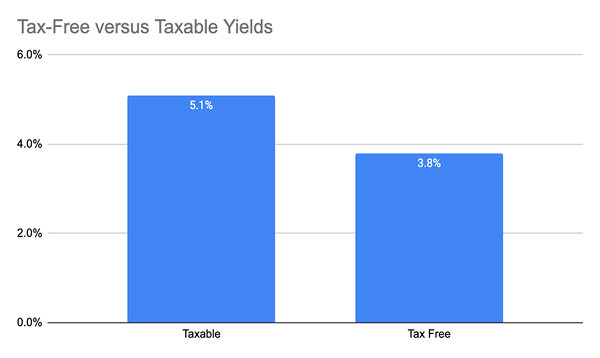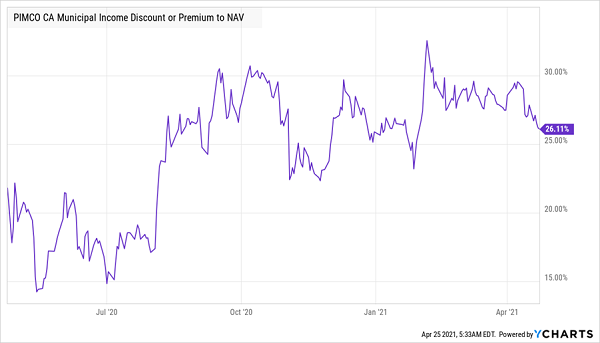Infrastructure spending is back in vogue, and we’ve got a chance to grab a piece of it tax-free.
That would be through municipal bonds, investments most people see as sleepy (though I have no idea why) but are poised to roll as President Biden’s $2-trillion infrastructure package (or some version of it) becomes law. That’s because the law will usher in an explosion of new “muni” bonds—and there are select actively managed closed-end funds (CEFs) ready to pick up the best ones.
By buying them now, we can nicely front run this muni-bond wave.
Tax Savings Can Boost Your Payout 20% (or More)
The best part of buying muni bonds (which are issued by states, cities and some non-profit entities, like hospitals, to fund infrastructure) is that the income they generate is 100% tax-free. This boosts the yield these funds offer considerably, especially if you’re in a higher tax bracket.

Source: CEF Insider
For instance, a municipal-bond yield of 3.8% may not sound like a lot (although in today’s market, 3.8% is still generous, since it’s over twice what you’d get from the S&P 500), but it’s the same as getting a 5.1% yield from dividend stocks if you earn $100,000 per year, thanks to their tax-free status. Plus, municipal bonds are less volatile than almost all other assets, making them a great wealth protector, in addition to an income generator.
This is why muni bonds are popular among high-income earners, and that popularity has caused some out-of-whack demand for some muni-bond funds. Take, for instance, the PIMCO California Municipal Income Fund (PCQ), a muni-bond CEF with a long history and a steady dividend that yields 4.4%. This one is so popular that investors are willing to pay $1.26 for every dollar of municipal bonds it holds!
PCQ Buyers Line Up to Overpay

The good news is that there are still bargains to be had in muni-fund land, and we can find them by going a bit beyond popular choices like PCQ. Here are three worth your attention now.
Muni-Bond CEF #1: Playing the California Mispricing
The BlackRock California Municipal Income Trust (BFZ) is an ideal way to get a 3.6% tax-free yield and capital gains over the long haul, thanks to its 9.7% discount and the fact that it focuses on California muni bonds. Since Californians have one of the highest tax burdens in the country, a lot of them look for funds like BFZ. (And yes, you can still get tax-free income from BFZ if you don’t live in California.)
BFZ’s discount will likely draw in more income-seekers, likely including some PCQ holders shifting from the pricey PIMCO fund to the cheaper BlackRock one as a way of arbitraging this mispricing. That should add to the fund’s upside.
And if you’re worried an exodus from the highly taxed Golden State will hurt the value of California’s bonds, don’t be. Just 135,600 people left California in 2020, on a total population of 39.5 million. There are millions of Californians who can benefit from the tax-advantaged nature of California municipal bonds, leaving a big pool of buyers within the state itself for BFZ.
Muni-Bond CEF #2: A Focus on Safety at a Bargain
Our second fund boasts a slightly bigger discount (10.6%) and a slightly higher yield (3.7%) that BFZ: the Nuveen Ohio Quality Municipal Income Fund (NUO), so named because it invests 80% of its portfolio in highly rated muni bonds issued by organizations ranging from the Ohio Turnpike to the Cincinnati water system.
That makes it safer than your average muni-bond fund (which is already pretty steady) and therefore ideal for adding stability to your portfolio. But you’re not sacrificing performance to get this ultra-stable fund: it still easily beat the benchmark muni-bond ETF, the iShares National Muni Bond ETF (MUB), in the last decade:
Beating the Benchmark With Less Risk

NUO’s prudent portfolio management and market outperformance make it a nice choice for stability, gains and income—whether you live in Ohio or not.
Muni-Bond CEF #3: A Massive Yield From the Garden State
Our final pick is the best: the Nuveen New Jersey Quality Municipal Income Fund (NXJ), which, like NUO, invests 80% of its assets in high-quality bonds while also trading at a whopping discount to NAV: 11.7%, in this case. But that isn’t even the best thing about NXJ; its dividend is—its 4.7% yield is large for a tax-free muni-bond fund.
NXJ Beats the Index

NXJ has been on my radar for a long time—since back in 2018, when I highlighted it in a ContrarianOutlook.com article. Back then, muni-bonds were out of favor, due to rising interest rates. But NXJ outperformed the broader muni-bond market, giving investors an outsized 8.9% total annualized return since then, with tax advantages to boot. That’s a sign that this quality fund is mispriced at an 11.7% discount.
This Steady CEF “Mini-Portfolio” Yields 7.1% (With Double-Digit Upside)
Municipal bond CEFs, with their unbeatable stability and high, tax-free dividends, are a great foundation piece for your portfolio … which is why I’ve dropped my top buy among municipal-bond CEFs into the high-yielding 5-CEF “mini-portfolio” I recently assembled.
These 5 funds are perfect for today’s uncertain market, handing you a big slice of your return in cash, thanks to the 7.1% cash dividend this mini-portfolio throws off. Plus, these 5 funds are incredibly diverse: aside from municipal bonds, they hold blue-chip stocks, real estate investment trusts, top healthcare stocks and preferred shares and corporate bonds, too.
What’s more, these funds are cheap now, setting us up for serious gains as the income-starved masses pour in to tap them for their steady, outsized payouts.
The kicker: four out of these five funds pay dividends monthly, so you won’t be waiting a full three months for your next payout to drop into your account!
Full details are waiting in the exclusive Investor Bulletin I’ve prepared for you. Go right here to read it and position yourself to start collecting these funds’ massive 7.1% dividend—with most of that cash coming your way monthly.

Recent Comments